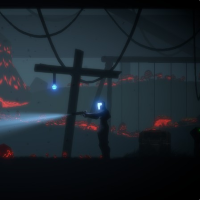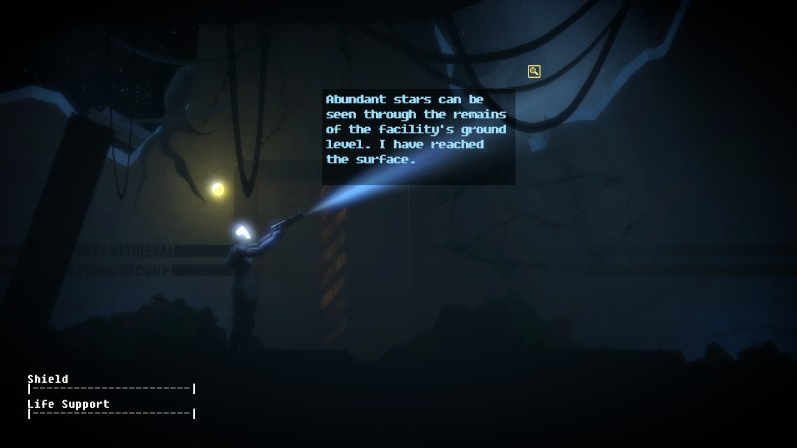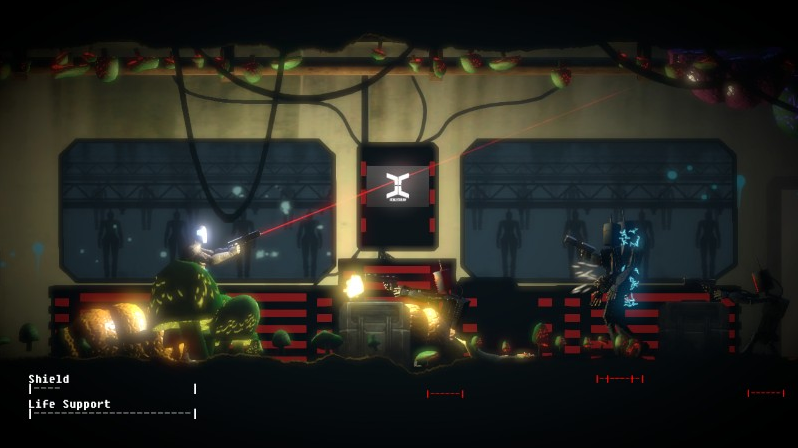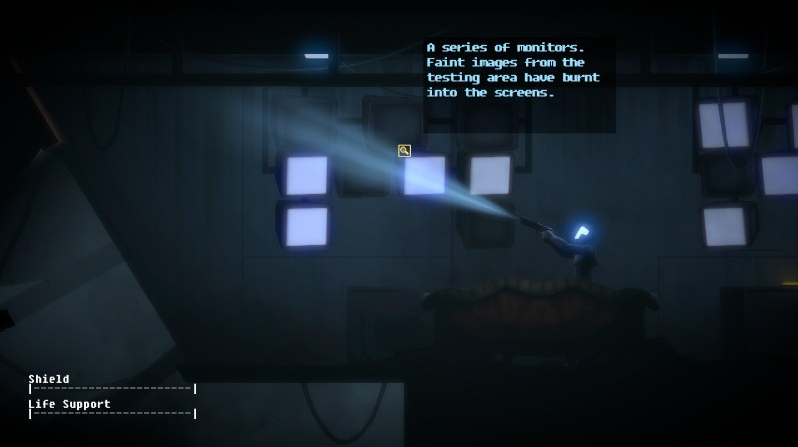
The Fall review

This golden age of indie gaming never fails to wow me. Excluding con artists assembling pre-packaged engine assets with no apparent effort or sense of design and selling those on Steam Greenlight as “original creations”, the genuine indie scene has excelled so far both in imagining some pretty original concepts for games as well as taking established styles and mechanics and honing them to a noteworthy degree of quality. Today, we’re going to talk about an example of the honing.
The Fall is the creation of Canadian independent game studio Over the Moon. Released on August 26, 2014 (on Wii U, just one of many platforms where you can buy it), this adventure/puzzle title puts the players in the boots of a military combat suit equipped with its own sophisticated brand of artificial intelligence. This Mark-7 A.R.I.D. crashes to the surface on an unknown planet with an unconscious and dying human pilot inside, a dude named Captain Josephs. The suit (called Arid by the other AI characters) activates automatically to secure the well-being of its owner. The mission here to to explore the planet and find some place where Arid can fulfill her duties to protect her pilot.
This premise plays out as simply as its gameplay. Arid moves on a 2D plane as she walks, jumps, aims her flashlight, and analyzes aspects of her surroundings. The Fall plays like a very straight-forward cave exploration game with a fair amount of puzzle elements as things progress. Yes, it’s very Metroid. Even in the way that Arid must acquire permission to use new abilities. Find tools in the environment. Find their proper use somewhere else. Connect the dots and advance deeper and deeper into this abandoned robot recycling facility. Very Metroid, indeed.

The visuals of the game maintain simplicity with basic colors, black silhouettes of the foreground over lighter backgrounds, and the general lack of living human beings. This leaves the developers time to focus on animations, important visual cues for the puzzles, lighting effects, and the little details that make a world worth exploring.
All in all, the sense of atmosphere in this unnamed, underground robotics plant is great. It manages to feel dead and lifeless but still be full of possibilities. Anything can be down that hallway. Poisonous mushrooms? A domestic interaction training ground? Man-eating slugs? Crucified human corpses? After some time, I got the hang of what the game was asking of me. Where it was going to take me was always a mystery. This drove me to continue spelunking deeper and deeper, even though Arid’s compulsion to save her pilot wasn’t something I was heavily invested in.
The simple premise of the Fall paves the way for the actual story of the Fall. Within this long abandoned robot recycling plant there are still some functioning systems keeping the lights on. There is an automated security robot called the Caretaker hunting down Arid and all other “defective units”. There’s also a piece of rogue management software that helps Arid over the speaker system. I haven’t been so entertained by an AI character since Portal 2.
There are shooting sequences in this game, too. They’re nothing to write home about. At best, they’re nice diversions into briefly exciting action bits placed intermittently throughout slower and player-led puzzle-solving. Let it never be said that I didn’t appreciate a change of pace.

The actual meat of the Fall lies in the puzzles. It’s here that this game doesn’t always hit the mark. By design, the interface and visual cues are stripped down to their barest. All you see is a stream of light from your flashlight, a glowing marker for objects that you can interact with, and a simple menu of icons. Unfortunately, this has led me to many moments of complete confusion. The amount of actual information being given to the player is minimal. As a result, we can’t always know what item will go where and why. So much of this logical connecting tissue is missing. And that’s a problem in some cases.
For example, there’s a point late in the game when, during a mock human life simulation, Arid has to console a crying baby (just a cardboard imitation in a dusty, moldy crib). The game at this point only has commands for flashlighting, shooting, wireless networking with objects, interacting manually with objects, and using all manner of tools, knives, and chemicals. None of these will work on the cardboard baby. The game provides zero indication what other triggers need to be in place for the morbid but spoilerific solution. Many tasks in the Fall are unclear, stodgy, and just plain baffling. How the hell was I supposed to know that I had to pull the cardboard grandmother out of her track to help her cross the street during the “help-the-elderly-human-lady-cross-the-busy-city-street” simulation? There are some serious logical cues missing throughout these puzzles.
The world that these virtual characters interact deserves some credit, though. The levels are compact enough that backtracking isn’t that much of a hassle. Like many games taking place in post society worlds, the Fall tells much of its story through the challenges and architecture, not just through dialogue and ancient human diaries. We learn that humans invented robots for military purposes and for domestic necessities like cleaning, cooking, and technical maintenance. Through their own negligence, the humans met their demise, leaving the robots to continue following their protocol without direct orders. Even more interesting is that the AI characters see value in their own existence. At some point, the player has to trash a whole storage room of domestic robots to advance. Arid and her guiding voice feel some resistance to it, as though robot life meant as much to them as human life.

All of this will probably lead to ideas that will be explored in further installments. As of now, the plan is for this to be a trilogy. I’m hooked by the story so far. I genuinely want to know where the story of Arid and her journey will end up. I want to know what happened to mankind. I want to know why they crashed on this planet in the first place and where they will go next. As far as the gameplay goes, I hope that future the Fall’s will work to add some much-needed clarity to the vague and confounding puzzles.
Despite my difficulties with the puzzling puzzles, I was pleased with the quality of art direction, writing, and the atmosphere. The Fall is another good indie title that deserves to rest happily in your virtual game collections. This likely just the first chapter of what will become a highly-praised indie classic series, faults and all. With a sequel in production, you have plenty of time to try out the Fall.
3/5
Recommended
Categories: Reviews
0 Comments
This post has been left all alone with no comments. Don't leave it lonesome - give it some company with a comment.